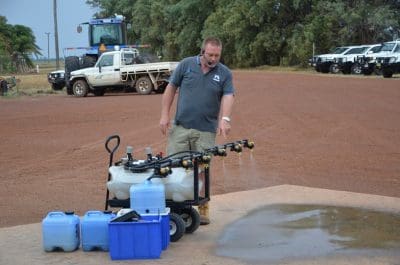SPRAY drift is of great concern for sensitive crops and environments, along with the fact that if the spray doesn’t hit the intended target, you do your dough and your weeds live.

Nufarm spray application consultant, Bill Gordon, says most growers are implementing best spray practice when it comes to boom height and nozzle selection but the temptation to spray at higher speeds and into the night can over-ride common sense at times.
Nufarm Australia spray application consultant, Bill Gordon, says the focus of spraying herbicide needs to be on doing the job right so the weeds receive the correct dose and die, and this includes reducing the air borne fraction to a bare minimum.
“In many cases this means not spraying at night if the wind speed is too low,” he said.
“Many product labels prohibit night spraying due mostly to the risk of spray drift. Our studies have shown that with a coarse spray quality drift may travel up to 300 to 400 metres during the day after any inversion has broken, but spraying at night can leave up to five times as much chemical in the air using the same products, nozzles and ground speed. This can result in spray drifting 10 to 20 kilometres or more at night, and this is unacceptable for other farmers, the community and the environment.”
Mr Gordon said most growers were implementing best spray practice when it came to boom height and nozzle selection but the temptation to spray at higher speeds and into the night could over-ride common sense at times.
“The flip side of this is that it is becoming more evident that using Delta-T as the main determinant of safe day-time spraying conditions may not be the best approach,” he said.
“What really matters most is the wind speed and whether the weeds are stressed or not.
“If the weeds are not stressed on a hot day, due to ample soil moisture, then spraying at a higher Delta-T may still be effective and safe, with course droplets surviving quite well and not becoming air-borne.”
This can essentially increase the number of daytime hours available to growers to get the job done without spraying at night or early in the morning when the risk of spray drift is the highest.

Getting onto paddocks as soon as possible after rain and using up the daytime hours to target priority paddocks will maximise weed control and minimise spray drift risk. Spraying can continue into the evening in summer if the soil remains warm and the wind speed stays above 12 km/hr. If the wind drops off, then spraying should cease, usually by about 10 pm through to a few hours after sunrise.
“Getting onto paddocks as soon as possible after rain and using up the daytime hours to target priority paddocks will maximise weed control and minimise spray drift risk,” Mr Gordon said.
“Spraying can continue into the evening in summer if the soil remains warm and the wind speed stays above 12 kilometres/hour. If the wind drops off, then spraying should cease, usually by about 10pm through to a few hours after sunrise.”
The bottom line is that it is very difficult to determine a safe night-time spraying conditions.
When environmental conditions are borderline in terms of wind turbulence, the safe spray window can be extended slightly through the use of coarser sprayer quality where the proportion of droplets less than 150 microns is 10 percent or less, keeping drift to a minimum.
The trade-off, however, is reduced efficacy when using very coarse droplet size, particularly when the target is small, vertical or hard to wet.
“When buying new nozzles, check them against the new standard, which shows spray quality with adjuvants rather than water only,” Mr Gordon said.
“The GRDC has recently updated and published the 2017 Nozzle Selection Chart for growers to use as a reference. Using the correct nozzle and adjuvant combination can have a positive impact in reducing spray drift and maintaining efficacy.
“Reducing ground speed by just 5km/hr can also make a big difference to spray coverage and efficacy of weed control, particularly if there is a high stubble load present.
“Water sensitive paper, in combination with apps such as ‘SnapCard’, is a good way to test the coverage, penetration and spray pattern achieved under different conditions, such as different ground speeds.”
Mr Gordon’s rule of thumb for effective weed control when applying fully translocated products (e.g. glyphosate and Group I) is a minimum of 6–8pc coverage, while coverage of 10–12pc or more is required for contact herbicides.
“Pre-emergent herbicides are the most difficult to judge due to the number of variables involved in their effective application, but as a rule of thumb I generally look for coverage of at least 15–20 percent,” he said.
………………
10 Tips for Reducing Spray Drift
- Choose all products in the tank mix carefully.
- Understand the product mode of action and coverage requirements.
- Select (and check) the coarsest spray quality that will provide effective control.
- Expect that surface temperature inversions will form as sunset approaches and will likely persist overnight and even beyond sunrise on many occasions. DO NOT SPRAY.
- Use weather forecasts to inform your spray decisions.
- Only start spraying when the sun is about 20 degrees above the horizon and when the wind speed has been above 4–5km/hr for more than 20–30 minutes, and clearly blowing away from any adjacent sensitive crops or areas.
- Set the boom height to achieve a double overlap of the spray patterns.
- Avoid higher spraying speeds.
- Leave buffers unsprayed if necessary and come back.
- Continue to monitor conditions, particularly wind speed, at the site during the spray operation.
For more information about managing spray drift, visit the WeedSmart website: www.weedsmart.org.au
Grain Central: Get our free daily cropping news straight to your inbox – Click here

HAVE YOUR SAY